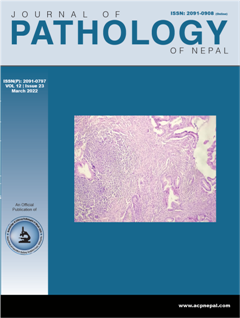Lupus anticoagulant: a clinical and laboratory diagnostic dilemma
DOI:
https://doi.org/10.3126/jpn.v12i1.37703Keywords:
Hypercoagulability: DRVVT; LAR APTT BCSH guidelines;Abstract
Lupus anticoagulants are a group of diverse autoantibodies that interfere in vitro in phospholipid-dependent clotting tests, and inhibit both the common and intrinsic pathways of coagulation. Paradoxically, they are implicated to cause hypercoagulability, thrombotic events in vivo in varied clinical settings like obstetrics and oncology.
A 56-year female was referred to the laboratory with complaint of repeated de novo clotting of drawn plasma samples. She was a post-operative case of surgery for superior mesenteric venous thrombosis, and a previously diagnosed case of squamous cell carcinoma of the buccal mucosa, not on treatment. The patient was evaluated clinically for new onset hypercoagulability and the history of exposure to heparin was negative, which ruled out heparin induced thrombocytopenia. The differential diagnosis were lupus anticoagulant, staphylococcal septicemia, and thrombotic thrombocytopenic purpura. On advanced work up, inhibitor screen was negative, dilute Russell's viper venom time was positive.
Downloads
Downloads
Published
How to Cite
Issue
Section
License
Copyright (c) 2022 Shalini Trivedi, Pooja Jain, Nutan Dixit, Manoj Arun, Udita Singhal

This work is licensed under a Creative Commons Attribution 4.0 International License.
This license enables reusers to distribute, remix, adapt, and build upon the material in any medium or format, so long as attribution is given to the creator. The license allows for commercial use.




